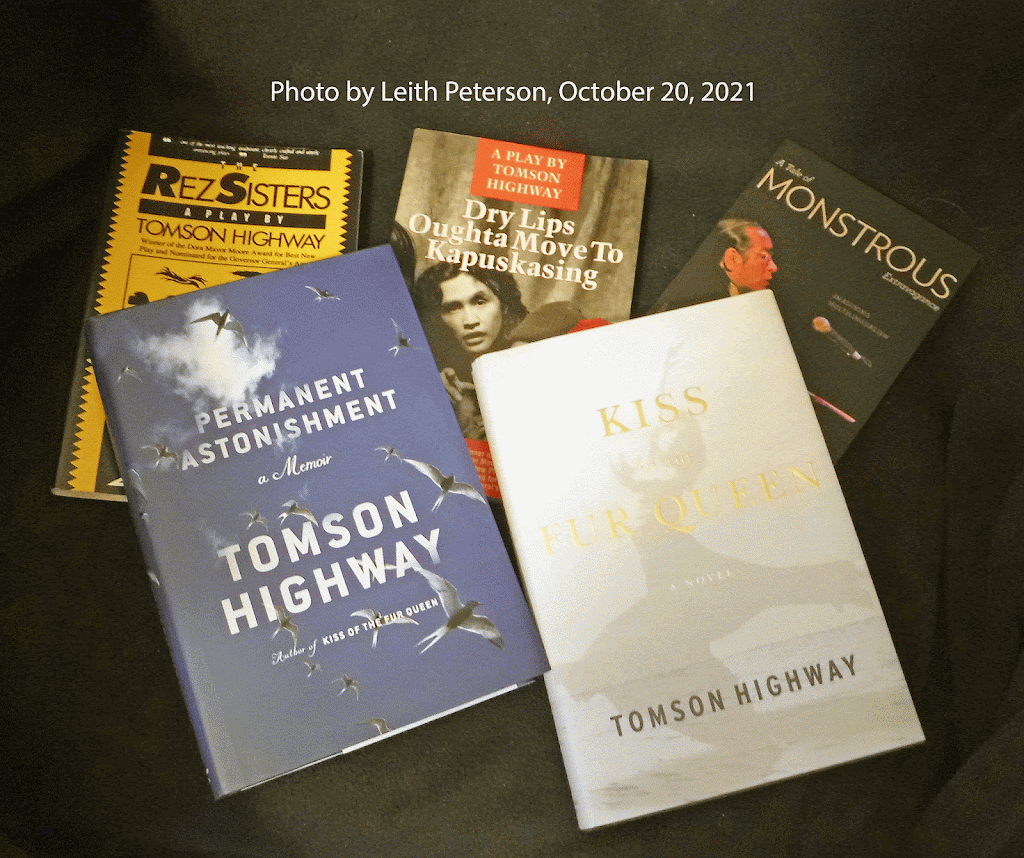Disclaimer: My references to the writings of other people–both Indigenous and Non-Indigenous–do not in any way imply that they share my views on this manner. The opinions expressed here are my own and do not necessarily reflect those of my family, friends or associates.
Acknowledgements: Tomson Highway, whom I have known since 1978, is OK with my writing this post; I have consulted with him about the content. Tomson’s partner Raymond Lalonde is also fine with my using the photos he took on August 20, 2021. James Stewart Reaney gave me the go ahead to discuss his November 2015 London Free Press article about Wacousta! Doug Struthers was happy to offer his feedback on the memoir and his friendship with Tomson and Rene (1954-1990). Thanks to the Ivey Family London Room staff for research assistance. Darshan Gunvantbhai Bhavsar has given me permission to thank him publicly for adding some coding to my blog. I needed to have this done in order to publish this post.
A Brief Synopsis of Permanent Astonishment
The central focus of this post will be Cree author and musician Tomson Highway’s memoir Permanent Astonishment (2021). Highway takes the reader on a fascinating journey through the first 15 years of his life. On December 6, 1951, he was born the 11th of 12 children in a remote Manitoba community. He describes his birthplace as “the most beautiful location on the face of this earth.”
His passages about the flora and fauna are often mesmerizing. For instance, he describes the sharp-eyed Arctic tern as an “aristocrat” that resides “almost exclusively in. . .permanent flight.” But Highway makes it clear the landscape can also be treacherous, e.g., when the spring melt turns the earth into a month-long bog.
His father, Joe Highway, did not want Highway’s life cut short by the challenging conditions the family were living under. He wanted his son to get an education so he could “save our people.” In September 1958, Joe put six-year-old Highway on a plane to the Guy Hill Indian residential school, 25 miles north of The Pas.
Two years later, in September 1960, Joe put his youngest son Rene (1954-1990) on the plane to join his brother at the school. Rene begged his parents to let him attend a year early because he missed Tomson so much. His parents relented because by the time Rene was born, they had seen so much death in their immediate family that they wanted both Highway and Rene to “go to a place where death” would not “get” them.
Highway’s father had wanted to go to school but could not because of his family situation. He resented the fact that his younger siblings had attended, but he remained illiterate throughout his life. Consequently, he advised Highway to get an education so he would not have to “undergo extreme suffering.”
Highway makes it clear what the “extreme suffering” entailed. The family had no indoor plumbing and had to haul water from the lake for cooking, washing, and drinking. They were often poor, so his father sometimes had to take out a line of credit at the store. At age 11, Highway became a six-days-a-week “fully accredited, professional commercial fisherman” because Joe did not have enough men to help him with his business. Although Highway enjoyed the time he spent with his father on these fishing expeditions, he acknowledged the strong winds and rain could make gutting hundreds of fish for “ten hours non-stop” very difficult.
I was not at all surprised when I learned Highway’s memoir had won the Hilary Weston Writers’ Trust Award for Non-Fiction (announced November 3, 2021). As the jury stated, Highway made a “bold personal choice to accentuate the wondrousness of his school years.”
And this wondrousness includes describing both the positive and negative. He presents Non-Indigenous clergy and staff as individuals, some good and some bad. In the good category are the Non-Aboriginals who worked long hours making many sacrifices for the benefit of the students (Miss Menard and the Christmas gift wrappers are two of numerous examples). Then there are those who gave Highway skills that have benefitted him for the rest of his life, like Sister St. Aramaa who taught him how to play the piano.
Highway also describes the Non-Indigenous clergy who wronged him and others, like Brother Lemoine who sexually abused not only him and his brother Rene but also many other male students at the school. However, Highway is not going to waste his time dwelling on abuse that happened 60 years ago. He wants to love and be loved by those who have helped him and given him joy throughout his life.
When Highway presents Non-Aboriginal behaviour that is counter-productive to his culture, he often does not take a heavy-handed approach. For instance, he describes the “token” system in which Sister Ann encouraged the Indigenous students to tattle on each other when they spoke their language. This contributed to a considerable amount of animosity between the pupils. Nevertheless, Highway explained Sister Ann’s reasoning. She was concerned the students would never learn their subjects such as history and social studies if they did not master the English language.
Quite a few residential school accounts speak of students being made to stay all year, but that was not the case at Guy Hill. They went home in July and August every year. Many residential school stories also complain about the food, but the Guy Hill students were well-fed. For example, they had turkey dinner with all the trimmings, including cake and ice cream, at Christmas.
Highway depicts both the positive and negative of Indigenous people before, during and after his residential school years. The most glowing praise is often reserved for his late parents Joe and Balazee Highway, who inspire him in many ways, e.g., their humour in the face of adversity, their belief in the importance of helping others and their prayers of thanks to their saviour Jesus Christ.
However, Highway also describes harmful experiences with Aboriginals, such as residential school dormitory “keeper” Stanley Blackbird who punched him in the head because he did not like Highway’s two-spirited (gay) behaviour.
Highway left Guy Hill with the highest mark in the school (95 per cent) and reportedly one of the highest scholastic standings in all of Manitoba.
Highway’s Activities, 1967 to September 1978
Highway continued to excel at a Winnipeg high school. At the University of Manitoba, he studied piano under the direction of William Aide. Aide moved to the University of Western Ontario in London, Ontario in 1974, and Highway joined him there to continue his instruction. In 1975, he obtained his Bachelor of Arts Honours (piano performance, major) and the following year got the equivalent of a Bachelor of Arts (English major) both from Western.
Before I continue with this post, I would like to explain how I got involved with Indigenous issues, which eventually led to my first meeting Highway in 1978 in London. I think it is important to frame my analysis within the context of my personal background.
Below is a photo of the front covers of books I own that are written by Highway:
Why Leith Peterson Got Involved With Indigenous Issues
I got introduced to Indigenous issues by my late parents when I was six. Around 1970, my father Charles T Peterson (1913-2007) put together a biographical sketch about my mother Jay Peterson (1920-1976). In this sketch, he said Mom “became interested in the plight of Indians” in 1958 “when she found a young Trinidad teacher helping the Indians of Muncey. . .and Oneida. . .during his summer vacation and Canadians themselves not doing it.”
The initial way Mom got involved with the reserve Indigenous women was by bringing their crafts to town, selling the items, and then returning with the money she had made to give to the women. What resulted were lifelong friendships with Native women in many different communities, such as Six Nations of the Grand River, Cape Croker, Oneidas of the Thames and Chippewas of the Thames.
From 1963 to 1970, Mom was on the Western Fair Board and helped organize events where Native people demonstrated, displayed and sold their crafts. Mom was also active, from 1964 to 1976, with the Indian-Eskimo Association of Canada (IEA) and its successor the Canadian Association in Support of the Native Peoples (CASNP).
The Fall 1978 CASNP Bulletin, entitled “On Native Women,” was dedicated to my mother. Joanne Hoople, the IEA executive director, described my mother as a “selfless worker throughout her adult life. . .who is remembered as someone who inspired others.” Hoople talked about my mother’s contribution to the establishment of the N’Amerind Friendship Centre (the London, Ontario Indigenous friendship centre) as well as her work “furthering the objectives of the Indian-Eskimo Association” and then CASNP.
My Father’s Interest in Indigenous Issues
My father shared my mother’s enthusiasm for Indigenous issues, particularly in connection with environmental stewardship. This was mainly because he was born and raised in Bruce Mines (near Sault Ste. Marie) Ontario and witnessed first-hand the problems caused by irresponsible development. Consequently, he had sympathies for Indigenous peoples’ concerns in this regard.
Dad often complained about the lack of trees in the First Nations communities he visited, so he decided to do something about it. He told me that every year, for many years, he gave thousands of saplings to Oneidas of the Thames and Six Nations–and planted some of them himself. No wonder his friends there called him the “tree man.” His funeral program included an “Iroquois prayer.”
I Got Involved With Indigenous Issues Because of My Parents
It is not surprising that I got involved with Indigenous issues because both my parents were very much engaged with the matter. I initially got connected in a variety of ways, such as going to the reserves with my mother and doing volunteer work at the N’Amerind Friendship Centre.
In 1973, I got my Library Technician diploma from Fanshawe College in London. This diploma led to my finding employment with the Indian Brotherhood of the Northwest Territories (IB-NWT) in Yellowknife, Northwest Territories, from May 1975 to October 1976. The IB-NWT (which became the Dene Nation in 1978) needed my expertise because they were participating in the Mackenzie Valley Pipeline Inquiry (MVPI) hearings. They wanted someone to organize the hearing transcripts and train a Dene man in library work.
When I learned my mother was terminally ill, I returned to London in October 1976, and remained with her until her tragic passing in December 1976. During the difficult time I spent with her before her passing, I was invited to a meeting at the Cross Cultural Learner Centre (CCLC). The CCLC was located at Westminster College on the University of Western Ontario campus. There were a group of Aboriginal and Non-Aboriginal people there discussing the formation of the Committee in Support of Native Concerns (CSNC). One of these people recommended I become the coordinator, so from November 1976 to July 1977, I filled this position. After I stopped being the CSNC coordinator, I continued as co-chair from August 1977 to August 1978.
From November 1976 to February 1977, I also secured a temporary, part-time position locating information for Don Simpson’s Native Studies class at Althouse College (now the Faculty of Education), University of Western Ontario. In August 1974, Simpson co-founded the “Southern Support Group” to help win support for the Dene cause in the south. My work with Simpson built on my employment with the Indian Brotherhood of the Northwest Territories (IB-NWT), 1975-1976. (As previously mentioned, the IB-NWT became the Dene Nation in 1978.)
In addition, from November 1977 to March 1978, I worked full-time on a government grant, developing a unique classification/cataloguing system for the Native people’s collection of the Cross Cultural Learner Centre.
How Leith Peterson Got to Know Tomson Highway
Around December 1977, Highway started working at the Native Peoples Resource Centre (NPRC)–his first job as an Indigenous activist. The NPRC was in the same location as the Cross Cultural Learner Centre. The Cross Cultural Learner Centre/Native Peoples Resource were by this time located at 247 Epworth Avenue in London.
I have the December 1977 Native Peoples Resource Centre newsletter, called NPRC News, where there is mention of the Festival of Native Music ’78 getting organized. Highway was the coordinator of this festival.
Around April 1978, Highway and I were asked to share a desk, because there were not enough due to funding limitations. I was concerned about how this arrangement would work out, but Highway was a perfect gentleman. For several months, we managed to share the desk and its contents in such an effortless manner, I wondered why I had even worried about it.
Highway hired five Indigenous women from five different reserves to assist him with the festival. They all worked together beautifully, laughing and loving every minute of it. Highway directed them as if he was conducting an orchestra. During August 1978, the festival took place in some Indigenous communities in the London area, at London’s Victoria Park, and on the University of Western Ontario campus.
Even though Highway had obtained funding from a variety of government and private sources, he needed more because of the scope of the entertainment. For instance, there were Inuit Throat Singers from Arctic Quebec and the Pueblo Youth Dancers from San Juan, New Mexico. When Cree singer Buffy Sainte-Marie was performing in Toronto, Highway spoke to her in Cree and convinced her to do a benefit concert at no charge for 400 diners at Western’s Great Hall. I was involved with this concert because the Committee in Support of Native Concerns was a co-sponsor. Sainte-Marie wowed the sold-out crowd on August 7, 1978.
Below is a photo of brochures, posters and articles I have relating to the Festival of Native Music ’78 and the Buffy Sainte-Marie benefit concert:
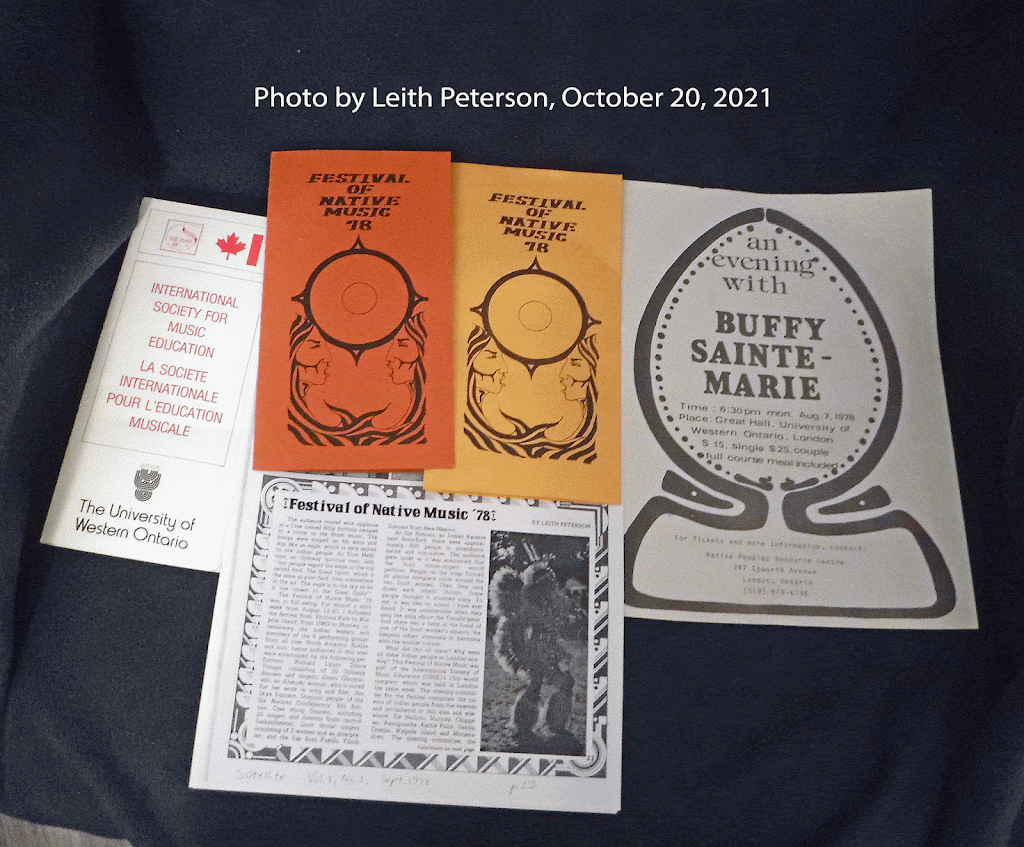 |
| Festival of Native Music ’78 and Buffy Sainte-Marie concert |
Peterson and Highway’s Connection, 1978 to 1998
From October 1978 until April 1987, I was employed primarily in Indigenous organizations in Timmins, Ontario and Yellowknife, Northwest Territories. Most of my work in this area involved training Aboriginal people in library work.
In October 1978, Highway moved to Toronto where he was active with a variety of Indigenous organizations. From 1986 onwards, his attention turned to the performing arts, and he started penning works himself. I really enjoyed discovering another dimension of his talent when I saw The Rez Sisters at the Factory Theatre in Toronto in 1988. Nanabush was expertly played by Rene in this production.
After completing my Canadian Studies B.A. at Laurentian University in Sudbury, Ontario, I returned to London in June 1989 to work on my Master of Library and Information Science (MLIS) degree at Western. I was happy to read in the Western News that Highway got an honorary doctorate in Music from Western in June 1993.
A couple of months before my MLIS degree was conferred in June 1994, I had a more extensive visit with Highway when I attended an Ottawa event to honour him after he got the Order of Canada. I also saw him very briefly when his The Rez Sisters was performed at the Grand Theatre in London in 1995.
In September 1998, Highway came to London for the launch of his novel Kiss of the Fur Queen. Afterwards, playwright James Reaney (1926-2008) and his poet wife Colleen Thibaudeau Reaney (1925-2012) invited me over to their place where I had a visit with Highway.
Highway the Cree “Coach” for James Reaney’s Wacousta! in the Fall of 1976
In the fall of 1976, Highway was the Cree “coach” for playwright James Reaney’s adaptation of Wacousta! which takes place in 1763. The play recounts Indigenous warriors led by Pontiac fighting against the British not too far from present-day London, Ontario. Although Highway did not participate in the final productions of the play, he gave guidance to the workshop participants. He carried down on a crowded bus moose antlers from Northern Manitoba. These antlers were used in scenes depicting elk in Scotland.
Although Highway’s involvement with Wacousta! was limited, he was inspired by some of Reaney’s other works, such as the Donnelly trilogy. Reaney made him realize that “world-class literature” was being produced in London. Reaney also encouraged him to write about Indigenous “people and places.”
Doug Struthers Friend of Both Tomson and Rene Highway (1954-1990)
In the mid-1970s, Londoner Doug Struthers became friends with Highway and his brother Rene. Tomson borrowed Struthers’s car when he picked up Buffy Sainte-Marie from the airport, so she could perform at the August 7, 1978 concert mentioned above. Struthers’s car was then nicknamed the “Buffy mobile.”
Struthers’s reading of Permanent Astonishment reminded him of Rene’s delight in watching a toy train race around a track in a storefront window of a Yonge Street restaurant in Toronto. Although Tomson’s description of “permanent astonishment” in his memoir relates to the “godly kingdom” he comes from, Struthers believes that Rene demonstrated “permanent astonishment” in his love for everyday matters that most people would not pay much attention to.
Struthers also witnessed Rene’s “permanent astonishment” when he saw his brother perform at his April 1975 graduation concert. Tomson played Bach, Schumann, Schoenberg and Scriabin. Rene sat straight up in his chair, listening very intently. After the concert, Tomson’s piano teacher invited them all back to a reception at his place in London.
Below is a photo of Struthers, Highway and Highway’s long-time partner, Raymond Lalonde, taken August 20, 2021:
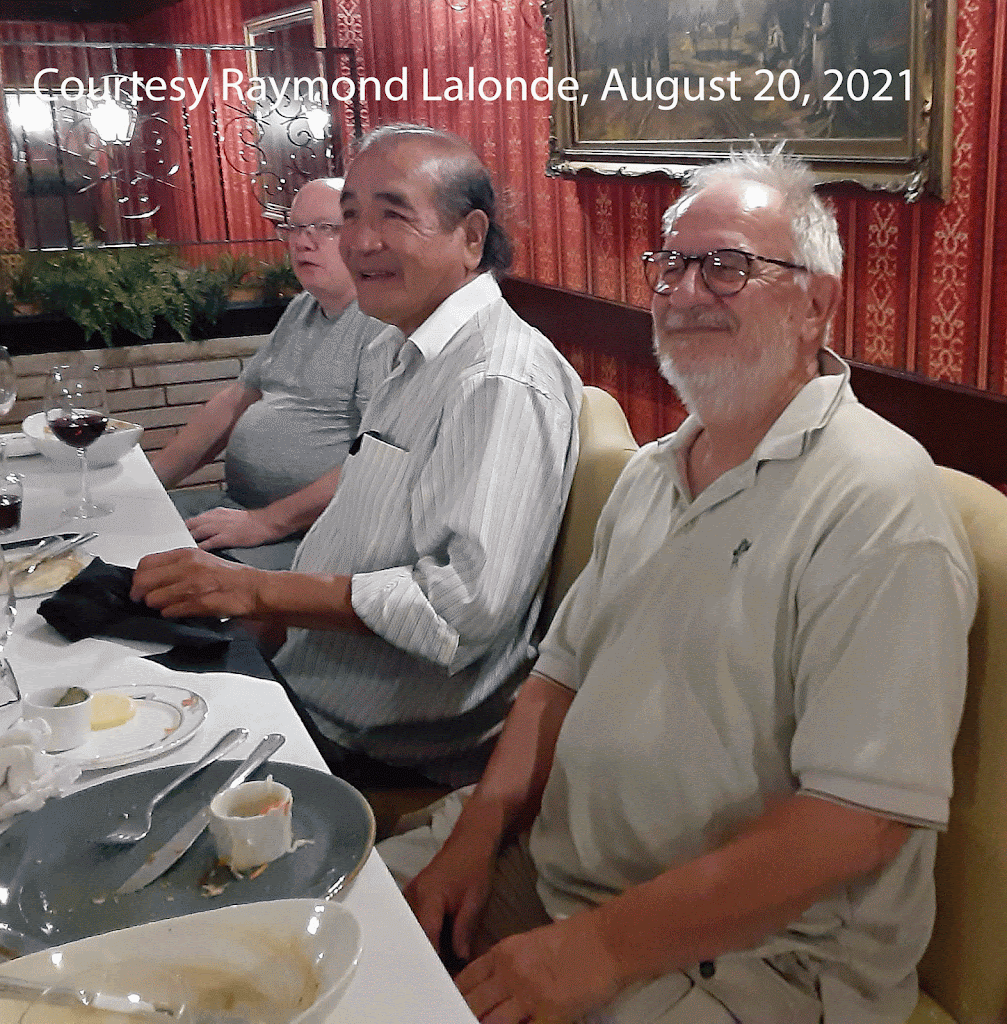
Saw Highway Again in September and November 2015
When I read that Highway was addressing the positive side of his residential school experiences, I contacted him to see if he would be willing to be briefly mentioned in a September 2015 https://www.counterpoise.ca post I was writing about the Truth and Reconciliation of Canada final report executive summary. Highway not only agreed to be quoted (my post was published September 7, 2015), but also invited me to be his guest when he was inducted into Western’s Faculty of Music Wall of Fame on September 25, 2015. James Reaney’s son, James Stewart Reaney, and his wife Susan Wallace, as well as Struthers, also attended Highway’s Wall of Fame event.
On November 8, 2015, James Stewart Reaney, Susan Wallace, their daughter Elizabeth Wallace Reaney, Struthers and I were also present when Highway gave a very interesting presentation to London’s Wordsfest, in partnership with Western’s Indigenous Services. “An Afternoon With Tomson Highway” included him playing the piano and a question-and-answer session.
Below is a photo of my Highway ephemera, 1988-2015:
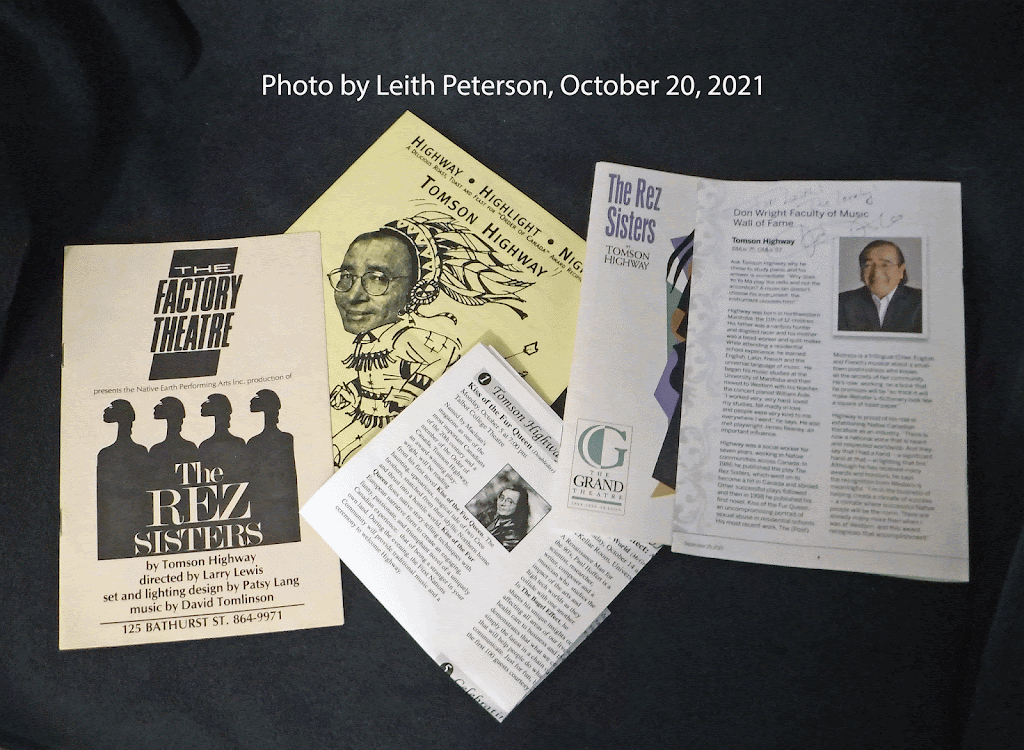
Met Up with Highway Again in August 2021
Almost six years later, I saw Highway again on August 20, 2021. This was when Highway, his long-time partner Raymond Lalonde, Struthers, James Stewart Reaney and I enjoyed a delicious supper at the Budapest Restaurant in London. Highway and Lalonde were on their way to Stratford to see Highway’s The Rez Sisters, which had a successful run there. The three photos of our get together are courtesy of Lalonde.
Below is a photo of Struthers, Highway and me that was taken at the dinner:
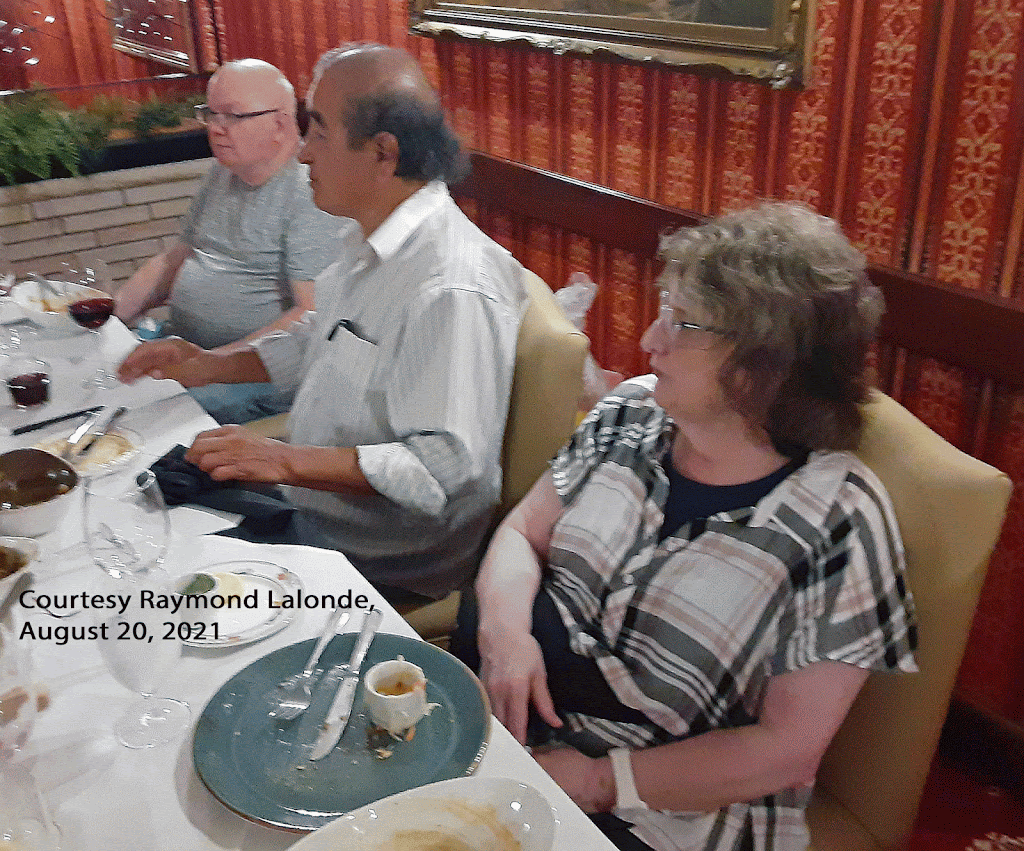
Conclusion
Highway has not changed at all since I first met him in 1978. His internationally renowned stature and his numerous awards have not gone to his head. I think this is mainly because he knows he has not achieved these heights alone. He frequently praises those around him, including Non-Indigenous people, who have helped him along the way.
Past challenges do not fell him but make him stronger. He has fully taken to heart what his father told him: the most disgusting vegetation makes the best manure. In the manure of Highway’s life, he has produced a beautiful garden, vibrant with music. He is a gem and I am happy to call him my friend.
A toast to Highway’s accomplishments, now and in the future!
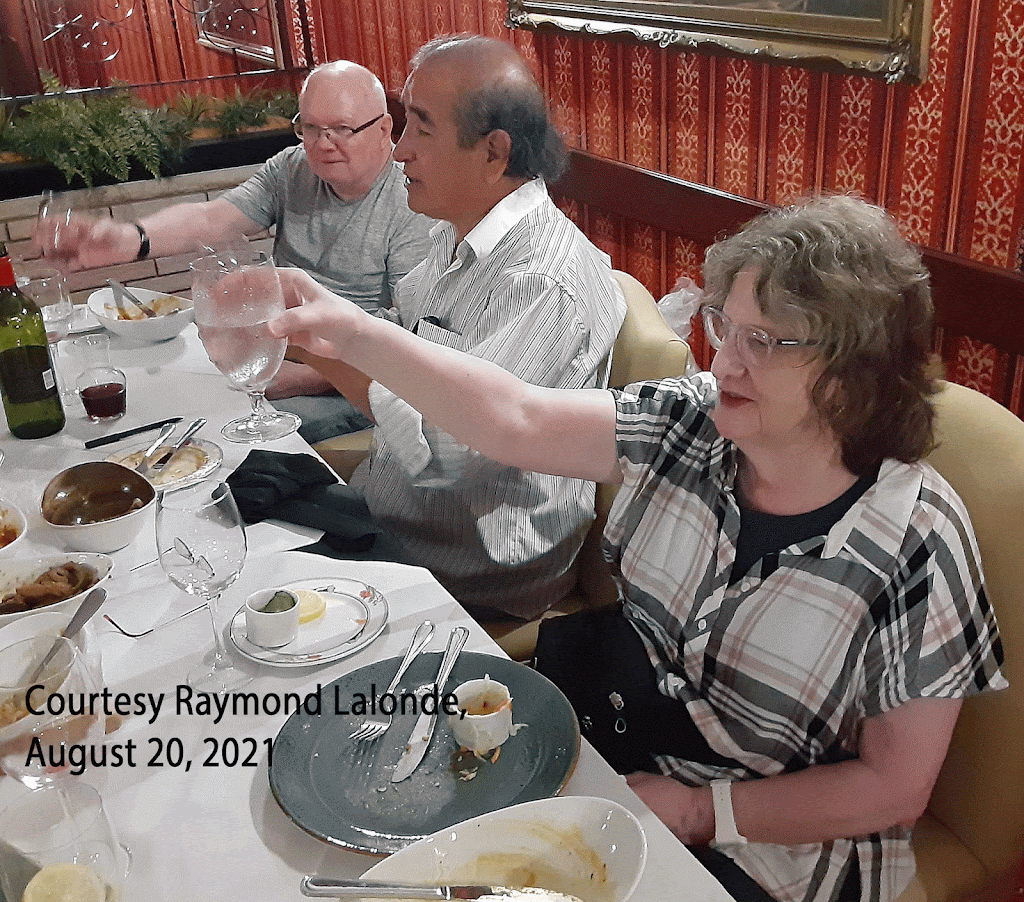
Bambury, B. (2017, June 30). No one is stopping Tomson Highway from having a happy Canada Day. Retrieved from CBC: https://www.cbc.ca
Canadian Press. (1992, September 26). Reaney influenced playwright. London Free Press.
CBC Radio – Q. (2021, October 13). Today on Q: Tomson Highway, Brent Spiner. Retrieved from CBC: https://www.cbc.ca
CBC Radio – Unreserved (2021, November 12). In new memoir, Tomson Highway reveals his secret to his ‘utterly positive spirit’–his parents. Retrieved from CBC: https://www.cbc.ca
Festival of Native Music ’78. (1978). Festival of Native Music ’78 [brochure]. London, Ontario
Gallagher, N. (1998, October 3). The creative drive of Tomson Highway. London Free Press, pp C1-C2.
Gillespie, I. (1995, February 10). Highway brings Sisters home. London Free Press.
Hamilton, J. D. (1994). Arctic Revolution: Social Change in the Northwest Territories, 1935-1994. Toronto: Dundurn.
Henderson, M. (2021, November 6). Highway recalls residential school, family bonds and more in new memoir. Retrieved from Winnipeg Free Press: https://www.winnipegfreepress.com
Highway, T. (1987-1988). The Rez Sisters [program]. Toronto. The Factory Theatre.
Highway, T. (1995). The Rez Sisters [program]. London, Ontario: The Grand Theatre.
Highway-Highlight-Night [program]. 1994, April 14. Ottawa.
Johnson, R. (1998, October 8). Tomson Highway: the Spirit of a Storyteller. Scene, p. 21.
Kapoor, A. (1995, February 15). The Rez Sisters makes a battle of bingo. Gazette, p. 9.
Matyas, J. (1995, February 11). The Rez Sisters stirs audience to wild applause. London Free Press.
Mulhern, M. (1978, August 8). Buffy’s native talk impressive. London Free Press.
Native Peoples Resource Centre. (1978, August 7). An evening with Buffy Sainte-Marie [poster].
Newman, R. (1978, July 26). Buffy helping to launch festival. London Free Press, p. D10.
Newman, R. (1978, August 17). Costumes hide the stories behind native dancers. London Free Press.
Newman, R. (1978, August 15). Indian dancers stop the clock. London Free Press, p. A10.
Nestruck, J. K. (2021, August 1). The Rez Sisters gets a miraculous production at Stratford Festival. Retrieved from: Globe and Mail: https:/www.theglobeandmail.com
Ostroff, J. (2015, December 15). Tomson Highway Has a Surprisingly Positive Take on Residential Schools. Retrieved from HuffPost Canada: https:www.huffpost.com
Peterson, C. T. (1970?). Peterson – Jessie Royce (Fleming) – “Jay Peterson” [biographical sketch]. unpublished.
Peterson, L. (1978, September). Festival of Native Music ’78. Satellite, pp. 23-24.
Quill and Quire. (2021). Permanent Astonishment by Tomson Highway [review]. Retrieved from Quill and Quire: https://quillandquire.com
Reaney, J. S. (2015, October 30). CanLit stars to shine at Words fest. Retrieved from London Free Press: https://lfpress.com
Reaney, J. S. (2015, November 14). The Highway at journey’s start. London Free Press, p. E4.
Richer, S. (1993, May 29). Tomson Highway: His road to success has been a long one. London Free Press.
Schaefer, N. (1998, October 3). Highway’s first novel a winner. London Free Press, p. C15.
Talbot, B. (1978, August 11). Buffy: a time for change. The Summer Gazette, p. 8.
The Book Store at Western & USC Speakers. (1998, October 5). Autumn Writes II: Tomson Highway’s Kiss of the Fur Queen [program].
Tomson Highway. Biography. Retrieved from Tomson Highway: https://tomsonhighway.com
van Koeverden, J. (2021, November 3). Katherena Vermette, Tomson Highway and Cherie Dimaline among winners at Writers’ Trust Awards. Retrieved from CBC: https://www.cbc.ca
van Koeverden, J. (2021, October 7). Tomson Highway’s memoir, Permanent Astonishment, is written as a ‘symphony to life’. Retrieved from CBC: https://www.cbc.ca
Western Alumni. (2015, September 25). 41st Annual Alumni Awards Dinner [program]. London, Ontario
Western Faculty of Arts and Humanities. (2016, January 6). Words Fest 2015: An Afternoon With Tomson Highway. Retrieved from You Tube: https://www.youtube.com
Western News. (1993, March 16). Distinguished contributions to be honored. Western News, pp. 1,4.
